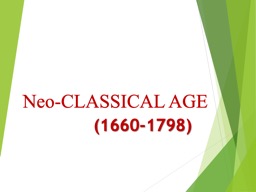

INTRODUCTION Neo Classical age is basically defined as the imitation of classicism Literally neo means new and classical refers to the style and works of the ancient writers of Greece and Rome Together it refers to the rebirth or revival of classical learning ID: 1019985
Download Presentation The PPT/PDF document "Neo-CLASSICAL AGE (1660-1798)" is the property of its rightful owner. Permission is granted to download and print the materials on this web site for personal, non-commercial use only, and to display it on your personal computer provided you do not modify the materials and that you retain all copyright notices contained in the materials. By downloading content from our website, you accept the terms of this agreement.
1. Neo-CLASSICAL AGE(1660-1798)
2. INTRODUCTION Neo Classical age is basically defined as the imitation of classicism. Literally ‘neo’ means new and ‘classical’ refers to the style and works of the ancient writers of Greece and Rome. Together it refers to the rebirth or revival of classical learning.
3. The period is called neoclassical because its writers looked back to the ideals and art forms of classical times, emphasizing even more than their Renaissance predecessors the classical ideals of order and rational control.
4. Neo- Classicism refers to the style and works of the ancient writers of Greece and Rome. It is also known as Age of Prose and Reason. Matthew Arnold called it as “Our excellent and indispensible 18th century”.
5. CLASSIFICATION OF NEO-CLASSICAL AGE It can mainly be classified into four parts- 1.Restoration Age(1660-1700) 2.Age of Pope(1700-1745)
6. 3.Age of Johnson /Age of Sensibility(1745-1798) 4.Age of Transition (1740-1798)
7. This was also the era of The Enlightenment, which emphasized logic and reason. It was preceded by The Renaissance and followed by the Romantic era. In fact, the Neoclassical period ended in 1798 when Wordsworth published the Romantic 'Lyrical Ballads'.
8. Classical writers tried to imitate the style of Greek and Romans that is why it was called as pseudo-classicism.
9. It is a prototype of classicism. Writers of the period followed the writers of the period of Augustus the Roman emperor, so this period is also known as Augustan Age (named after Augustus Caesar)
10. It was in a part a reaction to the bold ego -centricism of the Renaissance that saw man as larger than life.
11. Neo- classicists direct their attention to a smaller scaled concept of man as an individual within a larger social context and there is a need to be curbed by reason and decorum because they see man with vices.
12. Due to the emphasis on reason and exclusion of poetic touch, the age is also known as the ‘Age of Prose and Reason’.
13. Some popular types of literature included:ParodyEssaysSatireLettersFablesMelodrama, andRhyming with couplets
14. HEROIC COUPLETHeroic couplet was the popular medium of expression in Neo-Classicism.Heroic couplet is basically an arrangement of iambic pentameter in a rhyming pair of lines.It is mostly used in epic and narrative poetry for relating themes of heroism.
15. Examples of Heroic Couplet1.’Tis hard to say, if greater Want to skillAppear in Writing or Judging ill.”-An Essay on Criticism 2.Here Thou, great Anna! Whom three Realms obey,Dost sometimes Counsel take- and sometimes Tea. -The Rape of Lock
16. Periodical Essays In Augustan age there was the emergence of Journalism and Periodical Essays. Periodical essay, a kind of writing that is issued on a regular basis as a part of a series in edition such as journals, magazines, newspapers or comic books.
17. The periodical essay appeared in the early 1700s and got its success in the mid of 18th century.
18. The Tatler and The Spectator were popular periodicals of 18th century. Richard Steele and Joseph Addison were the chief exponents of periodical essays in 18th century. Periodical essays later led to the development of novels.
19. Age of Dr. Johnson Age of Johnson was dominated by Dr. Samuel Johnson who was famous for “Dictionary of English Language”(1745-55)
20. Comedy of Manners Comedy of manners were designed to satirise the vices and follies of the elite class. William Congreve, George Etherege, and William Wycherly are some known figures of this genre. The Way of the World by Congreve is best known examples of it.